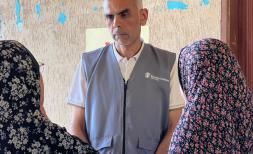To invest in our future, we must invest in our children

Amina is 13 and lives with her mother and siblings in a rural community in Nepal. She is not in school since the curriculum is only taught to grade five. “I only got to study up to grade five because that’s the maximum. I wish I could continue studying. It is very boring because all I do is stay home and help do household chores.”
For Amina to continue studying, members of the local school committee need to decide to invest more, but as Amina says, “they always say that there is not enough money."
This is an argument we hear time and again – not only from local decision-makers, but also by municipal and national governments, in rich and poor countries alike. How politicians decide to use available resources reveals their political priorities. Governments across the world have agreed and reconfirmed their commitment to children’s education and to gender equality. But lack of investments in quality services for children are one of the key barriers that prevent millions of children from reaching their full potential. This is especially true for the most marginalized groups of children, who are excluded from accessing education, health and protection services simply because of who they are or where they are from.

On this Universal Children’s Day, we are calling on governments everywhere to put their money where their mouth is. They need to make real the promise they have made to children in the UN Convention on the Rights of the Child and the new Sustainable Development Goals. Without investing more in children, it will be impossible to reach these goals.
Investing in children means we are investing in our future. The world of tomorrow simply cannot prosper if children of today are not healthy, educated and protected.
Globally, 121 million children are out of school. And more than half of the children out of school are girls. Girls face barriers to education on all fronts – from their schools, homes and communities – that include inadequate sanitation facilities, families prioritizing boys’ education over girls, and unsafe schools where they often face sexual violence or harassment.
One of the best ways to ensure equitable progress for girls is by investing in their education. When a girl goes to school, she boosts the educational prospects of her future children and delays the age at which she gets married, reducing health risks to herself and her babies during childbirth and beyond. Children born to a mother who can read are 50 percent more likely to survive past age five. By investing in the world’s excluded children, we can change the trajectory and create a better future for girls like Amina.

Investing in children can also makes sense economically. Data shows that every additional year of schooling for a child increases his or her future earnings by about 10 percent. There is also a strong correlation between the ability to read and write and reduced child marriage for girls. Only four percent of literate girls in sub-Saharan Africa and eight percent of literate girls in South and West Asia are married as children, compared with 20 percent of illiterate girls in sub-Saharan Africa and almost 25 percent of illiterate girls in South and West Asia.
A study shows that reducing health inequality by one percent per year could increase a country’s annual rate of GDP growth by 0.15 percent. Targeting the poorest children with increased access to health services can provide a strong policy alternative for improving economic growth.
To help break the vicious cycle of inequity, not only for girls but for all groups of excluded children, we need disaggregated quality data on the situation of children to inform political decisions on investments in children. Budgets must reflect our determination to fight inequity and ensure all children have a fair chance.
This is why Save the Children is calling for fair financing for children. Money must be raised and spent in ways that ensure every last child has access to the quality services and social protection they need to survive, learn and be protected. Necessary domestic resources need to be mobilized through progressive taxation, and where needed, supplemented with development aid to support the efforts of the poorest countries. And, increased and improved investment in children must be accompanied by the removal of cost barriers to essential services for children.
The United Nations have recently launched a set of comprehensive guidelines for governments on how to ensure more and better resource mobilization, budget allocation and spending on children and the realization of their rights. These guidelines will be invaluable for states in improving their investments in children.

Change is possible and change is happening. At a summit in Washington, DC in October this year, nine countries pledged greater investments in children, especially during their early years, powering their economies for long-term growth. The 2016 report of the International Commission on Financing Global Education Opportunity provides a unique opportunity to push political commitment to fund education for every last child and meet the Sustainable Development Goals to create a learning generation by 2030.
The Women Deliver conference in Copenhagen earlier this year gathered almost 6,000 people from 169 countries, including 2,500 organizations, 1,200 young people and representatives from private sector, UN agencies and government representatives, to discuss how progress can be made towards the Sustainable Development Goals applying a gender lens. The conference equipped participants with knowledge and inspiration to take action in their own countries and promote investment in girls and women to power progress for all.
These signs of progress are steps in the right direction, but more drastic changes will be necessary to create a world where all children learn, survive and are protected.
If governments are serious about reaching the Sustainable Development Goals, investing in every last child is imperative.

About the Author:
Jonas Keiding Lindholm has an MSc in Sociology and a BA in Communications. He is currently the Secretary-General/CEO of Save the Children Denmark. He is a visiting Scholar at Copenhagen Business School and Copenhagen University. He has formerly worked with Save the Children International, UN World Food Programme, Danish Refugee Council and Copenhagen University to name a few. He has various published research reports and publications on the complexities of children and youth, marginalization and social work.







